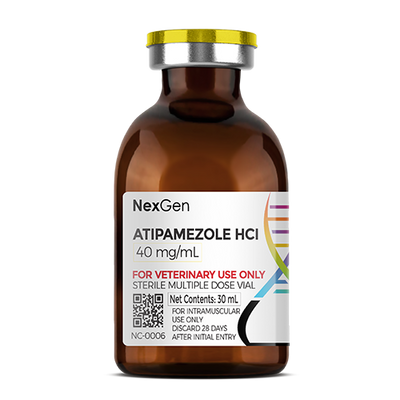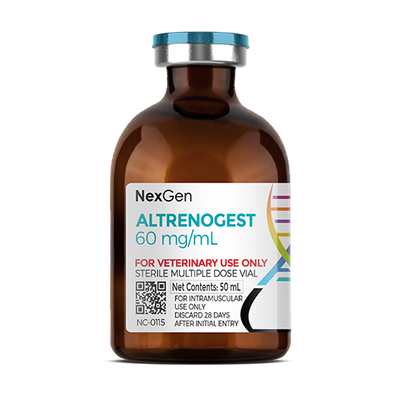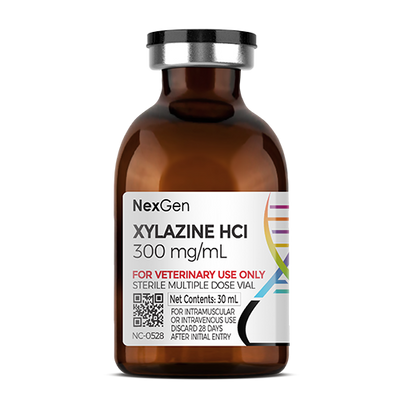
Atipamezole Hydrochloride 20 mg/mL, Injectable, (30mL)
Login for pricing
- Brand
- Mixlab
- SKU:
- NC-0005
- Product Type:
- Injectable
- Administration:
- Intramuscular
- Size:
- 30ml
- Therapeutic Class:
- Alpha2-Antagonist
Specific and selective α2-adrenergic drugs are widely used in veterinary anesthesiology. Among these is atipamezole (atipamezole hydrochloride), a synthetic α2-adrenergic antagonist that was developed to reverse the actions of compounds such as medetomidine and dexmedetomidine.
α2-adrenoceptor agonists such as clonidine and dexmedetomidine induce sedation, reduce anesthetic requirements, and improve perioperative hemodynamic and sympathoadrenal stability.1 Due to its efficacy compared to other drugs in its class, dexmedetomidine is currently being evaluated as an adjunct to anesthesia in humans. Compared with clonidine, dexmedetomidine is approximately 10 times more selective toward the α2-adrenoceptor and acts as a full agonist in some pharmacologic test models in which the former displays only partial agonism.2,3
Atipamezole Efficacy Studies
In a 1991 study, atipamezole effectively reversed the sedative effect of medetomidine in laboratory beagles. The dogs were sedated with medetomidine doses of 20, 40 and 80 μg/kg body wt i.m. Atipamezole was injected (i.m.) 20 min later at dose rates two, four, six and ten times higher (in μg/kg) than the preceding medetomidine dose. The dogs, though deeply sedated, showed signs of arousal in 3‚Äê7 min and took their first steps 4‚Äê12 min after the atipamezole injection. The dose‚Äêrelated reversal effect of atipamezole proved to be optimal with doses which were four, six or ten times higher than the preceding medetomidine dose. Drowsiness was found 0.5‚Äê1 h after atipamezole injection in 41% of the cases. No adverse effects nor cases of over‚Äêalertness or excitement were found.5
In cats, research showed similar results with regard to efficacy. From a 2019 study on male cats:
In total, 128 healthy male cats (age range 2–108 months, weight range 0.56–5.22 kg) admitted for castration were randomly allocated to groups of 32. Anaesthesia was induced with 60 mg/m2 ketamine, 180 µg/m2 buprenorphine, 3 mg/m2 midazolam and 600 µg/m2 medetomidine intramuscularly (IM). Cats received 600 µg/m2 (groups 1ATI20 and 1ATI40) or 1.5 mg/m2 (groups 2.5ATI20 and 2.5ATI40) atipamezole IM either 20 (groups 1ATI20 and 2.5ATI20) or 40 mins (groups 1ATI40 and 2.5ATI40) after the ‘quad’. Preparation time, surgical time, auricular temperature, times to sternal recumbency and first standing, and recovery quality score were recorded. Data were analysed using ANOVA, Kruskal–Wallis, Mann–Whitney U-tests and χ2 tests. Statistical significance was deemed to be P ‚©Ω0.05.6
In this study, the groups of animals not differ significantly in preparation or surgical time. Auricular temperature decreased significantly over time (P <0.01) but did not differ between atipamezole treatment groups. Time to sternal recumbency in group 2.5ATI20 (52.9 ± 22.3 mins) was faster than group 1ATI20 (65.7 ± 24.7 mins) (P ‚©Ω0.05), but there were no significant differences between other groups. Time to first standing and recovery quality scores did not differ significantly between groups.6
Atipamezole administration after 20 minutes did not reduce recovery time but neither was recovery quality adversely affected compared with when it was administered after 40 mins, following datasheet recommendations with concurrent ketamine administration. The results of this study also suggest that an atipamezole:medetomidine dose ratio of 2.5:1 is more effective than 1:1 in reducing recovery time, regardless of timing of administration, although this only reached statistical significance for time to sternal recumbency when atipamezole was administered after 20 minutes.6
Dosages
Recommended dosages for atipamezole are as follows:
Reversal of dexmedetomidine or medetomidine (extra-label): 100 micrograms/kg IV or IO (intraosseous) as part of CPR to reverse alpha-2 agonists. Dosage is based on a 10 micrograms/kg dexmedetomidine dose. If a higher dose of dexmedetomidine was administered, increase this dose accordingly.7 Treatment of amitraz toxicity (extra-label): 50 micrograms/kg IM; doses may need to be repeated every 4 to 6 hours as the half-life of amitraz is longer than atipamezole in dogs.8
Cats - Reversal agent (extra-label):
a)Reversal of medetomidine, when used alone or in combination with other sedatives or analgesics: Use an equal volume IM of atipamezole as medetomidine was used in the combination.7
b)Reversal of dexmedetomidine or medetomidine: 100 micrograms/kg IV or IO as part of CPR to reverse alpha-2 agonists. Dosage is based on a 10 microgram/kg dexmedetomidine dosage. If a higher dose of dexmedetomidine was administered, increase this dose accordingly.7
c)Reversal of xylazine sedation (when xylazine is used as an emetic): 25 – 50 micrograms/kg IM or IV (slowly).8
Rabbits/Rodents/Small Mammals
a)Rabbits: For medetomidine reversal (extra-label): 0.5 mg/kg IM or SC; 0.25 mg/kg IV.9
b)Mice, Rats, Gerbils, Hamsters, Guinea Pigs: To reverse xylazine or medetomidine (extra-label): 0.1 – 1 mg/kg IM, IP, IV or SC.10
Horses - Reversal of alpha-2 adrenergic agonist (eg, amitraz, xylazine) toxicity (extra-label): 0.1 mg/kg IV has been suggested.9
Ruminants - Reversal agent for alpha-2 adrenergic agonists (eg, xylazine, detomidine); (extra-label):
a)Bovine, new world camelids, ovine and caprine species: 0.02 – 0.1 mg/kg IV to effect.11
b)Small ruminants, camelids: 0.1 – 0.2 mg/kg slow IV or IM; as a rule of thumb, if induction included ketamine or Telazol® do not reverse alpha-2 sooner than 30 and ideally 60 minutes after induction. This will allow enough of the ketamine or tiletamine to be metabolized.12,13
Birds - Reversal agent for alpha-2 adrenergic agonists (eg, xylazine, dexmedetomidine); (extra-label):
a)0.5 mg/kg IM.14
b)250 micrograms/kg intranasally has been reported in pigeons. Antagonism of side effects and sedation was observed, but complete recovery had not occurred after 10 minutes.15
Reptiles - Reversal agent for alpha-2 adrenergic agonists (extra-label): Reversal of all dosages ketamine/medetomidine combination with atipamezole is 4-5 times the medetomidine dose.16 Reversal may take longer (up to one hour) in reptiles than in other species; Do NOT give IV as profound hypotension can occur.17
Zoo, Exotic, Wildlife Species - Refer to specific references, including:
a) Zoo Animal and Wildlife Immobilization and Anesthesia. 2nd ed. West G, Heard D, Caulkett N, eds. Blackwell Publishing; 2014.
b) Handbook of Wildlife Chemical Immobilization. 3rd ed. Kreeger TJ, Arnemo JM. 2007.
c) Fowler’s Zoo and Wild Animal Medicine Current Therapy, vol 8. Miller RE, Fowler ME. Saunders; 2015.
d)Exotic Animal Formulary. 4th ed. Carpenter JW. Saunders; 2012e) The 2009 American Association of Zoo Veterinarian Proceedings by D. K. Fontenot also has several dosages listed for restraint, anesthesia, and analgesia for a variety of drugs for carnivores and primates.
Atipamezole by NexGen safely and reliably reverses the effects of medetomidine and dexmedetomidine and is widely used in small and large animal practices, as well as in wildlife applications, such as deer.
Where to buy Atipamezole
Atipamezole is available in the U.S. through several pharmaceutical manufacturers and through veterinary custom compounding companies.
FOR RX ONLY: A valid prescription from a licensed veterinarian is required for dispensing this medication.
1Maze M, Tranquilli W: α2-Adrenergicagonists: Defining the role in clinical anesthesia. Anesthesiology 1991; 74:581-605
2Virtanen R, Savola J-M, Saano V, Nyman L: Characterization of the selectivity, specificity and potency of medetomidine as an α2-adrenoceptoragonist. Eur J Pharmacol 1988; 150:9-14
3Karlsson JOG, Andersson RGG, Grundstrom N: Characterization of pigment aggregating α2-adrenoceptorsof fish melanophores using different agonists after partial irreversible receptor inactivation. Br J Pharmacol 1989; 97:222-8
5Vainio, O. And Vähä‚ÄêVahe, T. (1990), Reversal of medetomidine sedation by atipamezole in dogs. Journal of Veterinary Pharmacology and Therapeutics, 13: 15-22. doi:10.1111/j.1365-2885.1990.tb00742.
6Bruniges N, Yates D. Effects of atipamezole dosage and timing of administration on recovery time and quality in cats following injectable anaesthesia incorporating ketamine. Journal of Feline Medicine and Surgery. 2020;22(6):589-597. doi:10.1177/1098612X19868547
7Fletcher DJ, et al. Recover evidence and knowledge gap analysis on veterinary CPR. Part 7: Clinical guidelines. Journal of Veterinary Emergency and Critical Care. 2012;22.
8Hugnet C, et al. Toxicity and kinetics of amitraz in dogs. Am J Vet Res. 1996;57(10):1506-1510.
9Vella D. Rabbit General Anesthesia. Proceedings: AAVAC-UEP 2009. 2009. Veterinary Information Network
10Adamcak A, Otten B. Rodent Therapeutics. Vet Clin NA: Exotic Anim Pract. 2000;3:1(Jan):221-240.
11Haskell R. Development of a Small Ruminant Formulary. Proceedings: WVC 2005. 2005. Veterinary Information Network
12Snyder J. Small Ruminant Medicine & Surgery for Equine and Small Animal Practitioners I & II. Proceedings: WVC 2009. 2009. Veterinary Information Network
13Wolff P. Camelid Medicine. Proceedings: AAZV 2009. 2009. Veterinary Information Network.
14Clyde V, Paul-Murphy J. Avian Analgesia. In: Bonagura J, ed. Kirk's Current Veterinary Therapy: XIII Small Animal Practice. Philadelphia: WB Saunders; 2000:1126-1128.
15Hornak S, et al. A preliminary trial of the sedation induced by intranasal administration of midazolam alone or in combination with dexmedetomidine and reversal by atipamezole for a short-term immobilization in pigeons. Vet Anaesth Analg. 2015;42(2):192-196.
16Heard D. Advances in Reptile Anesthesia. The North American Veterinary Conference 1999. 1999; Orlando.
17Mehler S. Anaesthesia and care of the reptile. Proceedings: BSAVA 2009. 2009. Veterinary Information Network.




















